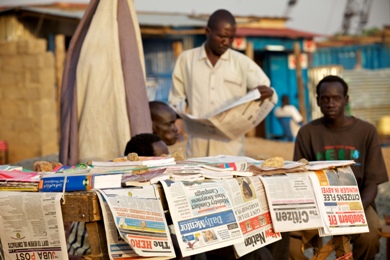S. Sudanese newspapers back on streets after two-day absence
February 1, 2017 (JUBA) – Newspapers hit the streets of the South Sudanese capital, Juba on Wednesday after fuel shortage saw printing suspended for at least two days.

Fuel was supplied to the printer on Tuesday, an editor posted on social media.
“For your information, we will have the newspapers out in the morning [Wednesday] (…The) issue of fuel resolved,” wrote Emmanuel Monychol Akop, editor in chief of The Dawn newspaper.
Alfred Taban, the editor in chief of the Juba Monitor newspaper said failure to print the paper’s early week editions led to financial losses.
“We [newspapers] depend on sales and adverts and without printing the papers, we are being forced to lose money and it will be very difficult to sustain the paper for a couple of days,” said Taban, also the Association for Media Development in South Sudan (AMDISS) chairperson.
South Sudan government solely imports fuel products through state-owned Nile Pet company. However, fuel has been scarce in the city, resulting to long queues and hiking prices at the black market.
Officials managing the distribution of fuel to various stations in Juba have been accused of indulging in the black-market sale of fuel.
Last week, South Sudan’s First Vice President Taban Deng Gai disclosed that his office used 10 oil tanks in six months without his knowledge, but vowed to investigate what could have happened.
“This is corruption and it must stop. Anyone involved will be punished,” Gail told a youth gathering at Juba stadium.
Since its independence, South Sudan has relied on oil for all income, a situation that has significantly compounded ongoing political and economic instability due to the fall in crude oil prices.
According to South Sudanese officials, production in the past reached as high as 350,000 bpd but fell after a dispute with Sudan over fees for pumping South Sudan’s crude through Sudan’s export pipeline, which led South Sudan to halt production in 2012.
South Sudan got the lion’s share of the oil when it split from Sudan in 2011, but it’s only export route is through Sudan, giving Khartoum leverage and leading to ongoing pricing disputes.
Even after restarting production, it never recovered to those levels, but it dropped to 245,000 barrels per day after the outbreak of the civil conflict in South Sudan in 2013, which hindered production in the oil-rich regions.
(ST)
